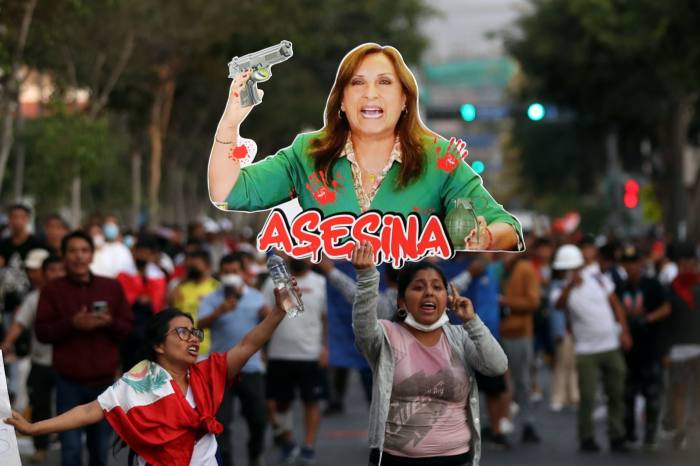[ad_1]
Margarita Condori, an elderly member of an Aymara indigenous community, rode for nearly two days on a bus from the impoverished Andean province of Puno to Peru’s capital Lima to take part in the mass protests that have rocked the country in the weeks since Dina Boluarte took over as president.
“Our people are suffering in poverty,” said Condori, as demonstrators chanted and horns blasted behind her. “They can call us terrorists but we are not, we are Aymara people, and we want justice.
“We will be here until Boluarte resigns,” she added.
Last week, 11,000 police officers were deployed as protests that have simmered across the country reached Lima, drawing thousands of participants. By nightfall on Thursday, skirmishes had broken out with protesters who threw rocks and set up barricades of rubble. Riot police fired tear gas into crowds and a large blaze engulfed a building in the city’s historic centre. The origin of the fire is unknown.
Peru has gone through five presidents in just over two years. Boluarte has been in office barely six weeks but protesters are already demanding her removal and fresh elections, a step that analysts fear may only worsen the political crisis gripping the world’s second-largest copper producer.
Boluarte was sworn in as president on December 7, hours after her predecessor, the leftist firebrand Pedro Castillo, was ousted and later arrested for attempting to close congress and rule by decree ahead of an impeachment vote. Boluarte, a career lawyer and political neophyte, had served as his vice-president.
Since then, protesters, particularly in the country’s mineral-rich but impoverished south, have taken to the streets, demanding that Boluarte step down. More than 53 people have been killed during the unrest, and there have been reports of live ammunition being used by security forces, drawing criticism from human rights organisations. Seventeen protesters and one police officer were killed in one day in the southern city of Juliaca last week.
Castillo faced multiple investigations for graft and had previously survived two impeachment attempts while in office. But he has maintained his support among much of the country’s poorer rural areas, where he represented a break with the status quo.
Boluarte has moved to bring elections forward from 2026 to April next year, with the winner taking office in July. Congress will vote for the second time on the measure next month. But even if approved, analysts worry it will not be soon enough to resolve the immediate crisis.
Getting lawmakers to sign off on a vote this year, thereby putting their own jobs in voters’ hands, is a tall order. Congress is the country’s least respected institution, with a disapproval rating of 88 per cent, according to the Institute of Peruvian Studies. Boluarte’s disapproval sits at about 71 per cent, similar to Castillo before he was removed from office.
“We don’t just want Boluarte out but with her all of the corruption that has taken root in Peru for years,” said Yamile Araya, a student from the province of Apurimac who was at the protests in Lima. “If the politicians are so smart, why have they left the country in such a broken state?”
Boluarte vowed to crack down on “vandals” who “want to break the rule of law” in a defiant late-night televised address on Thursday.
“It worries me that Boluarte’s Manichean discourse will only end up polarising society more,” said Gonzalo Banda, a Peruvian political analyst and columnist. “She is betting that the protests will deflate but she has not given an inch, and there has been no political cost to her administration after more than 50 deaths.”

At the root of the protests is dissatisfaction with Peru’s status quo, since the country transitioned to democracy in 2000 after a decade of autocracy. Driven by mining exports, Peru’s GDP doubled between 2001 and 2014 and wages increased, but much of the countryside was left behind, with wealth concentrated in cities. Meanwhile, corruption and mismanagement became endemic, with provincial governments misspending budgets.
Alongside calls for Boluarte’s resignation and immediate elections, some on the fringe are calling for a new constitution that would replace the current one, written during the dictatorship of Alberto Fujimori in 1993. That constitution established a unicameral congress and granted powers to the presidency to sideline lawmakers after votes of no confidence. Some protesters have even demanded Castillo’s release and reinstatement. A major workers’ union supporting the demonstrations has said that a second national strike will be called for February.
Elsewhere, demonstrators have blocked more than 100 highways and disrupted copper mining. On Friday, Glencore’s Antapaccay mine suspended operations because of an attack by protesters, while transportation from the Las Bambas mine, owned by the Chinese group MMG, was also reduced. Flights at airports in the cities of Juliaca, Arequipa, and tourist hub Cusco have been suspended, leaving travellers stranded. Machu Picchu, the Incan citadel, has been closed indefinitely because of the unrest.
Analysts say that the implications for Peru’s economy are severe. Alfredo Thorne, a former finance minister, expects the fallout to push the economy into a recession in the first quarter of the year.
Boluarte has emerged from the same political project as Castillo, as both once belonged to the Marxist Perú Libre party. But her detractors say she has betrayed the left, pointing to her cabinet of centrists and conservatives and the police crackdown on protests.
“Boluarte has crossed the Rubicon, she has burnt her ships,” said Francisco Tudela, a former diplomat and vice-president to Fujimori. “She cannot go back to the far left. They will not have her, even if she wants to go back to them.”
[ad_2]
Source link